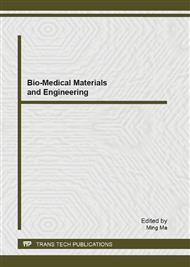p.270
p.273
p.277
p.283
p.289
p.293
p.299
p.304
p.309
A Fatigue Displacement Model of Atlantoaxial Subluxation, Model Validation and the Proposed Treatments
Abstract:
Traditionally, instant heavy impact has been believed to be the cause of atlantoaxial subluxation. However, none of our randomly selected 240 atlantoaxial subluxation patients were resulted from instant heavy impact. In fact, none of the patients was a laborer; 60% of the patients were at the age of 40-60; and the female patients were twice as much as the male patients. Therefore, a biomechanical model, called guyed pole, is proposed, which suggests that the major causes of atlantoaxial subluxation are accumulated trivial spine displacement and the loss of muscle strength due to long-term fatigue damage and inflammation. Atlantoaxial subluxation failure occurs after the accumulated stresses, due to spine displacement and incorrect cervical vertebra positioning, exceed the threshold of the injured muscle. During the treatment, the deformed cervical vertebra must be firstly restored to its original position, which may stop the uneven muscle stress distribution and further fatigue damage; then recover the muscle to its original elasticity and flexibility, which may increase the ability of muscle to resist cervical spine displacement; finally, correct postures during work and sleep are proposed to eliminate the damage of long-term fatigue stress.
Info:
Periodical:
Pages:
289-292
Citation:
Online since:
August 2013
Authors:
Price:
Сopyright:
© 2013 Trans Tech Publications Ltd. All Rights Reserved
Share:
Citation:


